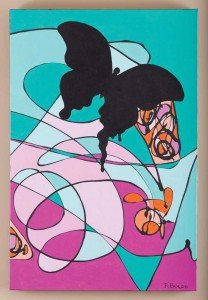+ By Julia Gibb + Photos by David Burroughs
Annapolis is joining a global movement toward embracing street art as a legitimate genre. Though the town is no stranger to public art, Roberta Pardo has ushered in a series of projects with a contemporary focus and a grand scale, bringing Brazilian street artists to Maryland to work in collaboration with local painters. The results: a cultural exchange for artists and viewers alike, as well as colorful murals with a distinctly urban flavor popping up in Annapolis’s picturesque but staid landscape.
It’s easy to imagine Pardo as the world-class equestrian she once was. Willowy and graceful, she commands attention with her confidence and bold sense of style. Her competitive horseback riding career once took center stage, compelling her to leave Brazil at 18 to train in Europe, but art has always been her other great passion. “In Brazil, we have so much art everywhere,” says Pardo, who grew up in São Paulo, where she studied industrial design at Fundaçao Armando Alvarez Penteado. Later, she would also study fine art and illustration at the prestigious Arts Center College of Design in Pasadena, California.
Pardo was drawn to Davidsonville, Maryland to work for an Olympic judge, training horses and giving riding lessons. She met her husband, Michael, in downtown Annapolis; the two married in 2001. Following the birth of the couple’s first child, she turned her focus again to art, finding work in 2013 with the Arts Council of Anne Arundel County. As the chair of exhibits, Pardo helps curate an ongoing series of shows at BWI Airport, where a new theme is introduced every four months. A similar program will be starting soon at the Anne Arundel Medical Center.
An extensive art collection dominates the bottom two floors of Pardo’s Severna Park home. The work she acquires reflects her affinity for street art and for its creators. “I like artists. I like to help them. I know it’s a hard life,” she says. Street art is a valued form of expression and community revitalization in Brazil, where it was decriminalized in 2009. There is an honesty and vitality in these public works that Pardo finds compelling. “I love street art because of its meaning,” she says, “it started—okay—as graffiti, as the [art of] rebels. But it really started because it was a voice for the people.”

Jeff Huntington
Last fall, Pardo brought internationally known Brazilian artists Branco, Gen Duarte, TIKKA, Vermelho, and Binho Ribeiro to Annapolis. The group attended the opening of LEGAL: Branco, Gen Duarte, TIKKA, Nick Alive, and Vermelho, a traveling exhibition that made appearances at George Washington University’s Gallery 102 in Washington D.C. and Porter Contemporary in New York City. The five, along with local artists Jesse James, Jeff Huntington, and Charles Lawrance, executed a sweeping collaborative mural at Park Plaza, each painting a section of the 400-foot-long retaining wall with figurative, sometimes surrealistic, imagery. Photographs of the work were featured in the winter issue of Up.St.Art magazine. The artists exchanged techniques and friendships as local musician Jonathan Stone provided a samba serenade. The project expanded into more murals: in Annapolis at Lemongrass on West Street, and at The Tattooery in College Park, Maryland. In addition, a workshop was held at ArtFarm, where young participants had an opportunity to meet the Brazilian artists, and to create their own street art-inspired work.
Though many have responded to the new murals with enthusiasm, some don’t know what to make of them. This in itself is part of what Pardo enjoys about presenting work out on the streets. “I think it’s fascinating, and I really like it,” she says, “I like to be a little bit of that ‘wild card’ in a good way, to surprise people.” Her affection for Annapolis is clear as she rhapsodizes about the beauty of the Chesapeake Bay, the historic nature of the town, and the many activities the area has to offer. At the same time, she sees an opportunity to introduce new ideas. “You have to be able to adapt to the times without forgetting the history.”
This year, Pardo plans on bringing local artists to Brazil and more Brazilian artists to Annapolis. She is also working on creating a permanent wall for temporary art, a concept modeled after New York City’s Bowery Mural, which, since 2008, has served as an outdoor exhibition space for multiple contemporary artists. She hopes that the community will see these installations as an invitation to slow down and join the visual conversations happening around us, locally and internationally: “We are all so busy, right? I have the three kids and the family, and then suddenly we run into a situation like this, where we have to stop and think, and realize that there is so much more out there than [what] we have in our everyday lives.”




